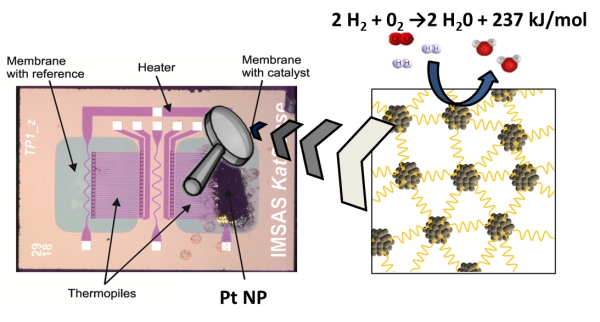
home | staff | research | teaching | lectures/seminars | how to find us | intranet
Deutsch | English

home | staff | research | teaching | lectures/seminars | how to find us | intranet
Deutsch | English
Catalytic hydrogen gas sensing is a potential safety approach for sensing H2 in working environments where reaching a critical hydrogen concentration may lead to serious accidents. Especially the detection of leakages demands sensors with short response times. For this purpose, catalytic micro-sensors are suitable, which exhibit a very fast response while consuming a low amount of power. The sensing principle is based on the highly exothermic combustion of hydrogen with oxygen. Hence, such sensors require catalysts which are stable at high operating temperatures, show a high sensitivity for this reaction even at low gas concentrations, and remain stable for long operating times.
Platinum nanoparticles (NPs) are ideal candidates due to their ability to effectively catalyze the oxidation of hydrogen. However, the high operating temperatures together with the exothermic character of this reaction typically lead to NP sintering and therefore to fast deactivation of the sensor.

To overcome these limitations, we developed a new class of hybrid material based on Pt NPs, linked with bifunctional organic ligands (exhibiting at least two anchoring groups) to create a three-dimensional NP network. No support is needed and very high Pt NP densities can be achieved being crucial for the application of such materials as catalytic H2 sensors. Particle preparation and linking is achieved in two separate steps so that NPs from the same cluster batch can be used for the preparation of different ligand-linked NP networks. Hence changes in the properties of different ligand-linked NP networks can be exclusively related to the linking ligand. Depending on the flexibility or stiffness of the ligands, we are able to achieve different sensing properties.
Eva Morsbach, Sebastian Kunz
References:
Cooperation partner: W. Lang, IMSAS, Universität Bremen
Funding: BMBF
For detailed information contact Sebastian Kunz